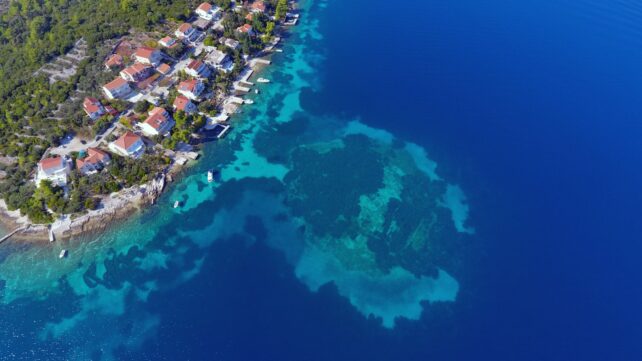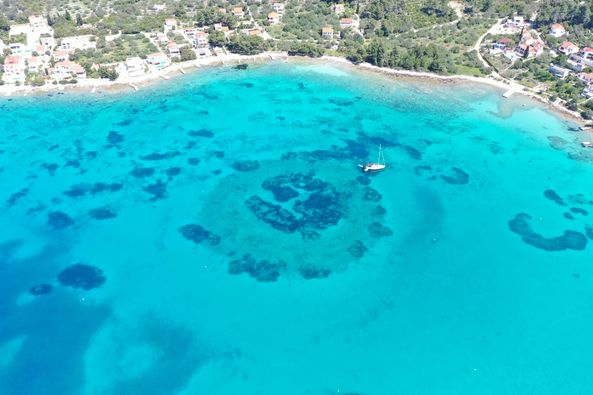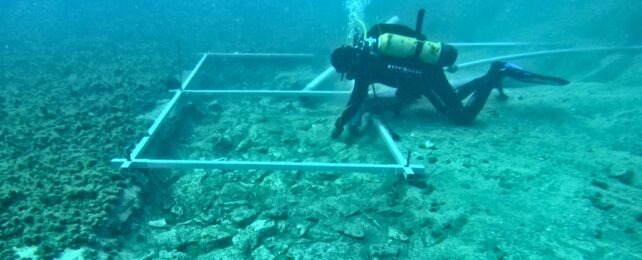Archaeologists have unearthed the remnants of a 7,000-year-old road hidden beneath layers of sea mud off the southern Croatian coast.
Made at the sunken Neolithic site of Soline, this exciting find may once have linked the ancient Hvar culture settlement to the now isolated island of Korčula.
Once an artificial island, the ancient site of Soline was discovered in 2021 by archaeologist Mate Parica of the University of Zadar in Croatia while he was analyzing satellite images of the water area around Korčula.

After spotting something he thought might be human-made on the ocean floor, Parica and a colleague dove to investigate.
At a depth of 4 to 5 meters (13 to 16 feet) in the Mediterranean's Adriatic Sea, they found stone walls that may have once been part of an ancient settlement. The landmass it was built upon was separated from the main island by a narrow strip of land.
"The fortunate thing is that this area, unlike most parts of the Mediterranean, is safe from big waves as many islands protect the coast," Parica told Reuters in 2021. "That certainly helped preserve the site from natural destruction."
The newly discovered prehistoric road has been protected from powerful waves for millennia thanks to these islands too.
At around 4 meters (13 feet) wide, the thoroughfare was constructed of carefully stacked stone slabs. Today it's covered in a thick layer of mud, as you might expect for an underwater structure.

Researchers think that the Neolithic Hvar culture, which once inhabited the eastern Adriatic, constructed the now-submerged Soline settlement and the ancient passageway that connected the islands.
Through radiocarbon analysis of preserved wood, the entire settlement was estimated to date back to approximately 4,900 BCE.
"People walked on this [road] almost 7,000 years ago," the University of Zadar said in a Facebook statement on its most recent discovery.
This remarkable research is the result of collaboration among experts from Dubrovnik Museums, the Museum of the City of Kaštela, the University of Zadar, the City Museum of Korčula, along with the assistance of photographers and divers.

This isn't the only secret that Korčula's been keeping. The same research team has discovered another underwater settlement on the opposite side of the island that is strikingly similar to Soline and produces some intriguing Stone Age artifacts.
University of Zadar archaeologist Igor Borzić recently noticed intriguing structures beneath the bay's waters. So the researchers diving at the Soline site went undersea exploring, and to their great delight, they discovered an almost identical settlement submerged at a depth of 4 to 5 meters.
"Neolithic artifacts such as cream blades, stone [axes] and fragments of sacrifice were found at the site," the University of Zadar adds.
The new settlement finds, like those at Soline and its connecting road, seem to have ties to the Hvar culture.
Around 12,000 years ago, the Neolithic era, also known as the new Stone Age, emerged in some parts of the world as we gradually transitioned from a hunter-gatherer lifestyle into farming and animal domestication, resulting in more permanent settlements of communities.
Multiple archaeological finds, skeletal remains, artifacts, computational modeling of genetic patterns, and many other sources such as 7,200-year-old Croatian cheese, contribute to our knowledge of Neolithic humans.
But island settlements from the Neolithic period aren't found as often. So these are exciting finds for archaeologists, showing how our ancestors could adapt to different environments and build roads between them.
